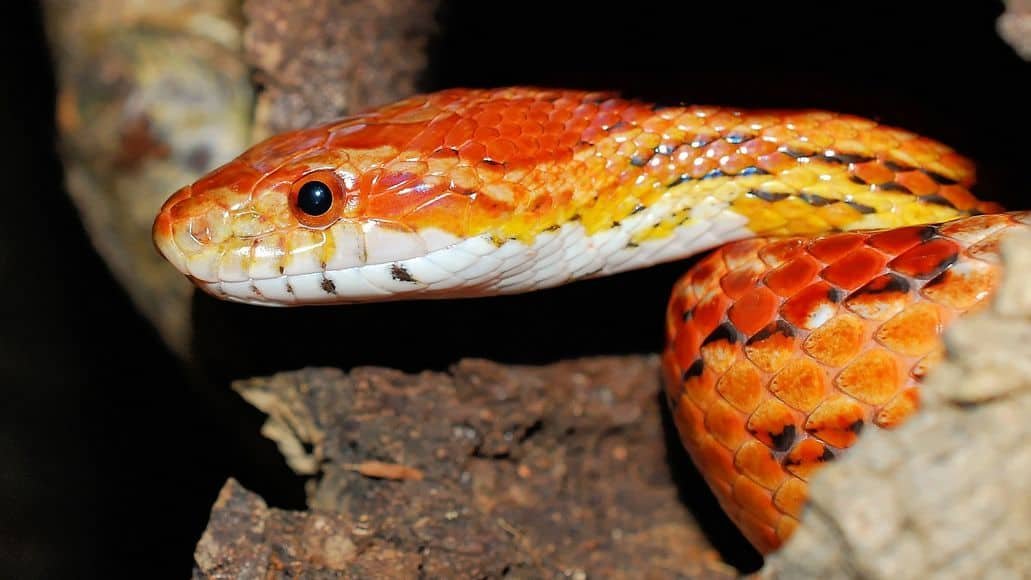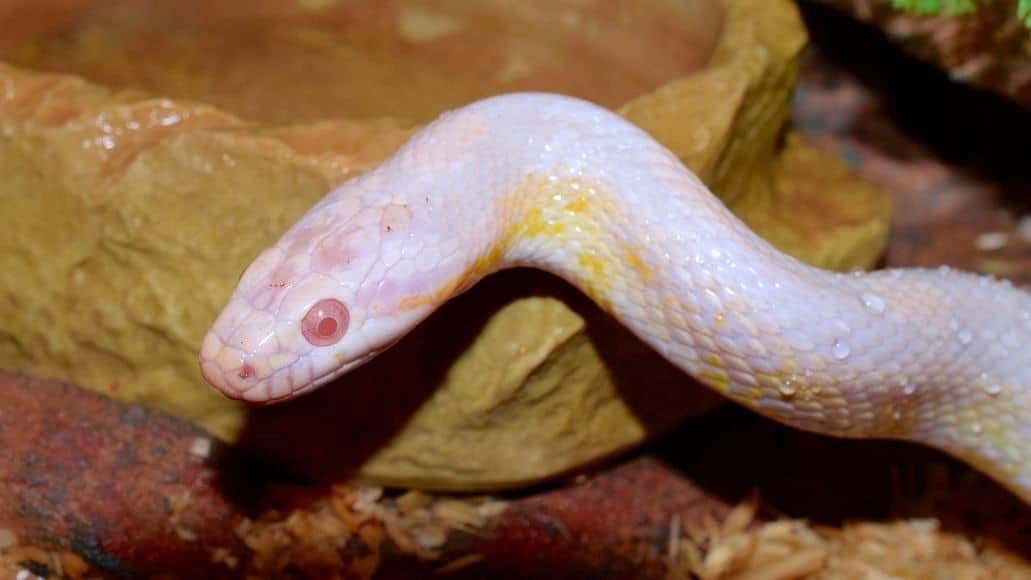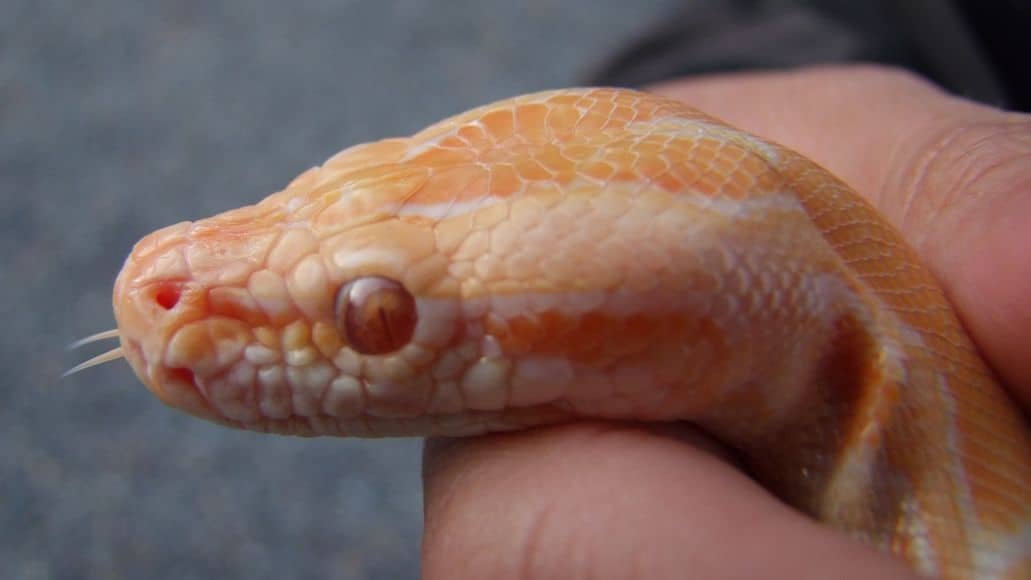
And so do snakes, especially the snow corn snake.
Many will still disagree, but more and more people are discovering what awesome creatures they are.
But getting a pet is not something to take lightly.
Even low-maintenance pets require basic care to ensure their well-being. Do not get a pet unless you are willing to offer that care—day in and day out.
Snow corn snakes are one of those low maintenance pets. They do not need to be walked or groomed, but they do need the proper enclosure, the proper environment, and the proper food.
We will cover everything you need to know to properly care for your new snow corn snake.
Table of Contents
- 1 What Is A Snow Corn Snake?
- 2 Snow Corn Snake Care
- 3 Caring For A Snow Corn Snake: Final Thoughts
What Is A Snow Corn Snake?
The Snow Corn Snake, known as the Complete Albino Corn Snake, grows to the same size as a normal corn snake – between 3 and 5 feet.
They’re also called amelanistic corn snakes because they lack melanin. The eyes are red, orange or pink against the pale pinkish-white skin.

The Snow Corn Snake is a constrictor. The snake will wrap its body around its prey and squeeze it to death before consumption.
The diet of the snake in the wild consists of mice, lizards, and birds. In captivity, you will need to feed it mice once or twice a week. Over time, you will get to know the preferred feeding habits of your particular snake.
Corn Snakes – Interesting Color Patterns
Corn snakes are non-venomous snakes, calm, medium-sized and easy to care for. This North American breed of snakes is one of the most docile of the rat snakes. They are part of the Colubridae family, an enormous family of about 1,760 species.
They come in many sizes, colors, and characteristics. Their interesting color patterns are determined by a difference in a certain gene and herpetologist use information about color genetics to breed varieties known as morphs.

There are about 45 different color morphs. Although the main color of corn snakes is red, orange, yellow and black, there are other corn snakes missing some of the colors – snakes with genetic variations of the color gene.
While all the different color morphs have unique names, they are all essentially all just regular corn snakes.
Snow Corn Snake Care
Don’t catch a wild snow corn snake. Wild snakes don’t adjust well to captivity and have a low survival rate.
Captive-bred corns have been in captivity for many years and are far more domesticated. You are much better off finding a good breeder.
Once you’ve acquired your snake, leave it alone for a few days to familiarize itself with the enclosure and to generally settle in. They become tame in a short space of time, becoming docile and even-tempered.
The snake will get used to you handling it. They are relatively hardy snakes and easy to maintain. They almost never bite.
Handle your pet snake gently, but with confidence. Always pick your snake up by the middle of the body, supporting it with both hands. If your snake has eaten, don’t pet it for 48 hours.
Providing Your Snow Corn Snake The Proper Home

A corn snake, just like any other wild creature, hates to be held captive. It is especially hard on them if their owner is new to the world of caring for pet snake.
Pet snakes are very sensitive and they need to be kept in the environment they are used to. Make sure you give your snake the proper habitat. They need the environment they are used to in nature, good hiding spots, comfortable substrate and their favorite food.
Get the right sized tank for your snake. To save on costs, bear in mind that your snow corn can grow to 5 feet as an adult. The minimum corn snake enclosure size is 20 gallons. 30 to 40 is better. Get a full-sized tank from the start, rather than buying a smaller one at first and having to upgrade later when your snake outgrows it.
Fill the bottom of the enclosure with a substrate. Most snake experts recommend Aspen Substrate which can be found at a pet store or online (see below). These substrates work superbly and are easy to keep clean.
Luckily, all of the items you need are readily available at most pet stores and can also be found on Amazon.
Items To Help Your Snow Corn Snake Feel At Home
- A snake terrarium with all the accessories
- The best substrate to make your snake comfortable
- Getting your snake a few snake hides will allow it to hide away when it feels threatened or to regulate its body temperature
- Stocking up on their favorite food is also important (if you buy froze mice, always make sure to let the little mice defrost fully before feeding; in their natural environment, snakes will never eat a fully frozen mouse, unless it snows in the middle of summer and they manage to find a frozen mouse somewhere)
Feeding Snow Corn Snakes
Feed your snow corn snake appropriately sized mice. You buy and store them frozen and let them thaw completely before feeding. True, some snakes prefer live prey, but that can pose a danger to the snake.
Live rodents can become ferocious out of fear and injure the snake. Never handle your Snow Corn after a meal, because you could cause it to regurgitate its meal. Wait 48 hours before handling your snake again.
Snow corn snakes generally need to eat every 7 to 10 days. However, corn snakes can go a long time without eating, if need be.
You don’t want your snakes to skip too many meals, though. Not getting enough food will affect how fast corn snakes grow.
Can corn snakes eat crickets or other insects, if you prefer not to feed them rodents? They can, but they probably won’t eat them. They tend to ignore insects as a source of food, because insects have a low body temperature and snakes hunt by sensing heat.
Cleaning Your Snow Corn Snake’s Habitat
Salmonella bacteria are a part of keeping a reptile. You need to do your part to keep it from spreading. This means particular care is required when cleaning all your snake’s gear.
Keep the cleaning of its accessories separate from washing your own stuff. Simply use liquid soap and household bleach or commercial terrarium cleaner from a reputable pet supply store.
Remove all old food and feces from items and wash each item in a solution of hot, soapy water. You can use a sponge to work away stubborn debris. Rinse exceedingly well.
Allow everything to dry thoroughly, preferably out in the sun, before giving the items back to the snake. An important point to remember is that hot water on its own won’t disinfect reptile gear. It needs to be washed in hot water and then disinfected.
It is important to clean the terrarium regularly, too. Just do it at the same time. Remove climbing toys or anything else that remains before cleaning.
Dip a cloth in the water and soap solution and wring it out. Wipe the entire terrarium out, making sure to remove all waste and old food. An old toothbrush can be useful for removing tough dirt on a glass surface or in corners.
Always let it air out and dry completely. It is also important to clean the cage and accessories with cleaning products that won’t be toxic and harmful to your pet.
When Your Snow Corn Snake Defecates
When your Snow Corn Snake defecates, remove the feces as well as the soiled substrate immediately and replace it with fresh substrate. Your snake may also defecate in its water bowl. It goes without saying that this should be cleaned immediately as well.

Provide Your Snow Corn Snake With Enough Heat
Provide your snow corn with enough heat. Corn snakes are nocturnal and like using heat from the ground. Provide the enclosure with a snake heat pad that covers about 1/3 of the floor to ensure a proper heat gradient. The heat mat will need to be thermostatically controlled.
Because the snow corn snake comes from North America, which has a temperate climate, high temperatures aren’t required. The cool end of the enclosure can be room temperature, and the hot end around 85° F.
You’ll see your snake using the hot side to regulate body temperature. In the enclosure, temperatures should be about 75 to 85° F during the day and 65° to 72° F at night. Bear in mind that the snow corn is an albino, and doesn’t do well in bright light.
Give your snake a cave or other hideout where it can feel secure and also go to regulate body temperature. These hides can be anything from natural, hollow barks or shop-bought hides. The idea is to ensure the enclosure with all accessories is as natural as possible and never toxic for your serpent.
Snake Mites On Your Corn Snake
Snake mites can live on your snow corn snake and feed off the snake’s blood. You’ll likely notice these mites around the eyes and mouth and also under the scales.
A snake with mites won’t want to eat and it will be lethargic. If you notice this body language in your corn snake, you’ll need to bathe your snake in warm water and also disinfect the vivarium to get rid of all mites. Medical attention may be required.
Other Potential Health Issues
Respiratory infections can also occur because of poor snake enclosure conditions and the wrong temperatures. Your snake will exhibit a nasal discharge and raspy, wheezing breath sounds. Veterinary intervention is required.
Know when your snake is going to shed. You’ll notice the reptile’s eyes glassing-over. Don’t handle your snake during the shedding process.
For much more, read our article on snake diseases.
Breeding In Captivity

If you want to go ahead with breeding, the breeding pair needs to be healthy. Females usually reach sexual maturity at around 3 years of age, while with males do so after 18 months of age.
If you’re not sure which you have, read about sexing your corn snake for help in determining it. Corn snakes are fairly easy to breed, and the introduction of the female to the male usually happens in spring.
The generally accepted method of breeding snow corn snakes involves a period of cooling which is known as brumation – something similar to hibernation. It involves stopping feeding 2 weeks before the cooling period starts.
Once the 2 weeks are over, decrease the temperature gradually and keep the snakes at a temperature of about 55 to 60°. Keep the snakes at this temperature for 2 or 3 months.
Don’t feed the snakes during this time. At the end of the cooling period, the snakes must be warmed up slowly to the regular maintenance temperatures. Begin feeding again.
After her 1st or 2nd shed, the female will be ready for introduction into the male’s cage. She produces pheromones to attract the male. Mating lasts 20 minutes to half an hour.
The female will require a nest box in a dark area to lay her eggs. She will settle down inside and lay her eggs – from 5 to 30 of them. Some snake experts say that the eggs are best incubated in the damp moss in which they were laid.
This article on breeding corn snakes has much more on the best way to incubate, and whether the eggs should be transferred to an incubator. After a couple of months, the baby corns will hatch from the eggs.
When the eggs start to hatch, the baby snakes open the eggs, sometimes taking a day or two to emerge.
Caring For A Snow Corn Snake: Final Thoughts
Corn snakes are a popular pet snake for beginners as well as seasoned snake owners. There are many different morphs – beautiful whites, pinks, greens, purples, and other shades.
The snow corn snake is a favorite due to its stunning white look. It is one of the most beautiful snakes on earth, With the right care, this stunning serpent will quickly become a happy member of your family.
Donna says
Thank you so much for this article! I’ve had four corn snakes in the past, but it’s been about eight years now sense. I just recently (within a couple of weeks ago) got my first albino snow corn. I have been trying to figure out how I’m supposed to know when this little guy is preparing to shed. Everybody on the snake sites keep telling me that their eyes don’t do the bluish gray like a dark eyed corn snake, therefore I have been totally confused. According to your post here, it does happen to the albino snows. Again thanks!
Aaralyn says
A hygrometer measures the humidity, which should be around 40 to 50 per cent, essential to keep your corn snake’s skin healthy and prevent breathing problems. If it’s too high, you’ll need more ventilation.
Maryann Shaw says
Is there any legal way of owning one of these beautiful snakes if you reside in the state of Georgia?
What is the reasoning behind the strange snake laws in my state?
Thanks,
Maryann Shaw
shawmaryann@hotmail.com
Asher says
This is a great care guide for new owners of snow corn snakes! It covers everything you need to know to keep your snake healthy and happy. Thanks for sharing!
alishea says
omg i want one!!!!!